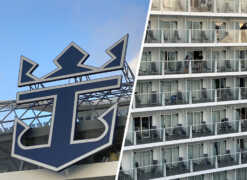We never know what life has in store for us, but certain things can rear their ugly heads to remind us of those things we have taken for granted. Several years ago the loss of most of my vision in one eye threw me for a loop, but I still had one perfectly good eye. Then, perhaps fatigued from having become my very dependable source of vision, that good eye retired completely from compensating for the deficiencies of the other eye. I had adapted to living with one good eye and one partially seeing eye. But, when the partially bad eye switched to being the better eye, my first thoughts focused on my ability to travel. How to Travel With a Visual Impairment? As an avid cruiser, I know that some of the benefits of cruising, especially unpacking once and knowing my living area, makes this form of travel more accessible. Most reassuringly, I know that the excellent crews aboard ships could provide assistance if necessary, even though stubbornness makes me reluctant to ask. I pretend to be independent. My first big cruise after vision loss was the Holland America Line Rotterdam trans-Atlantic anniversary crossing. At embarkation, I met a kind young woman who noticed something odd. Not my usual weirdness this time; perhaps my hesitation prompted her to offer to help me navigate the terminal. Knowing the layout of Holland America’s Pinnacle-class ships helped tremendously once I got on board, but also contributed to some imprudent overconfidence at times. I continue to learn new adaptation techniques and offer the following tips for others with visual impairment, knowing full well that none of us with this condition are exactly the same. Planning Seek a knowledgeable travel advisor who knows the intricacies of the ships. Let them know your challenges. Requesting a room near an elevator, dining area, or activity venue reduces chances of missteps. Take note of whatever impedes you. For me, it’s low and dark furniture or thresholds. Stateroom and bathroom entries may have high thresholds. An accessible stateroom may eliminate these hazards. American Cruise Lines’ new coastal catamarans had few thresholds on their ships. Upon boarding the ACL Glory, I headed to the dining room for lunch. I spotted an open table and suddenly found myself airborne followed by a face plant. Except for soreness everywhere and the embarrassment of being on display, I survived. Looking forward isn’t always the best advice for those with no peripheral vision nor depth perception. I had tripped over an unseen.… By Theresa RussellEXCERPT ONLY. CLICK TO READ THE FULL ARTICLE. This is an excerpt from the latest issue of Porthole Cruise and Travel Magazine. To continue reading, click above for a digital or print subscription.
Appeared first on: Porthole.com




